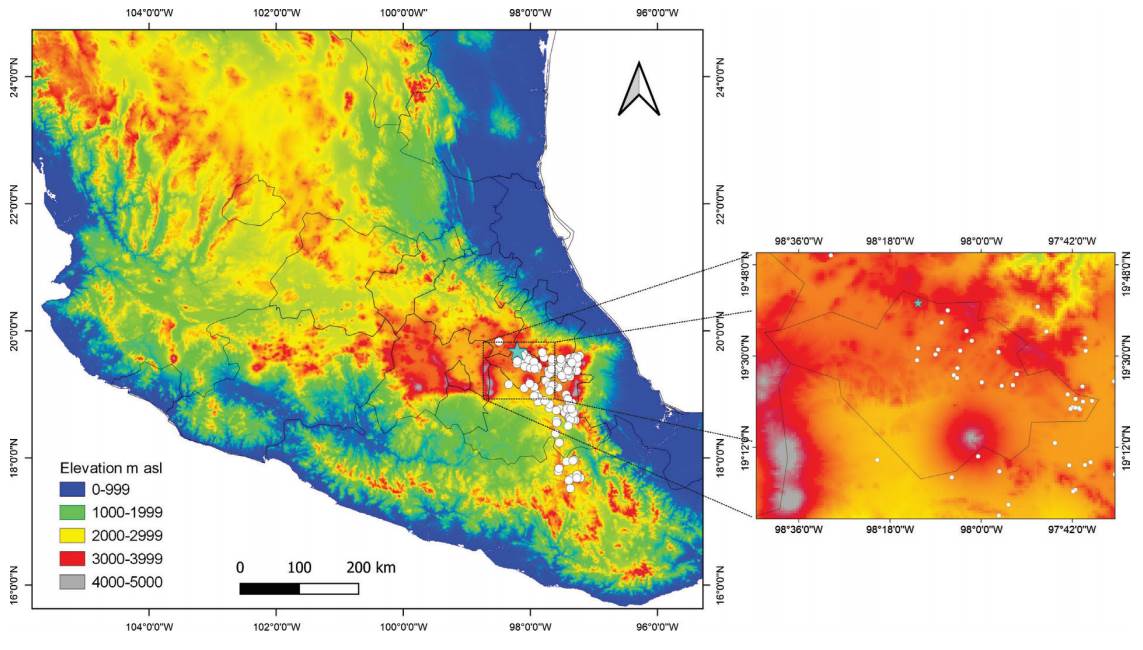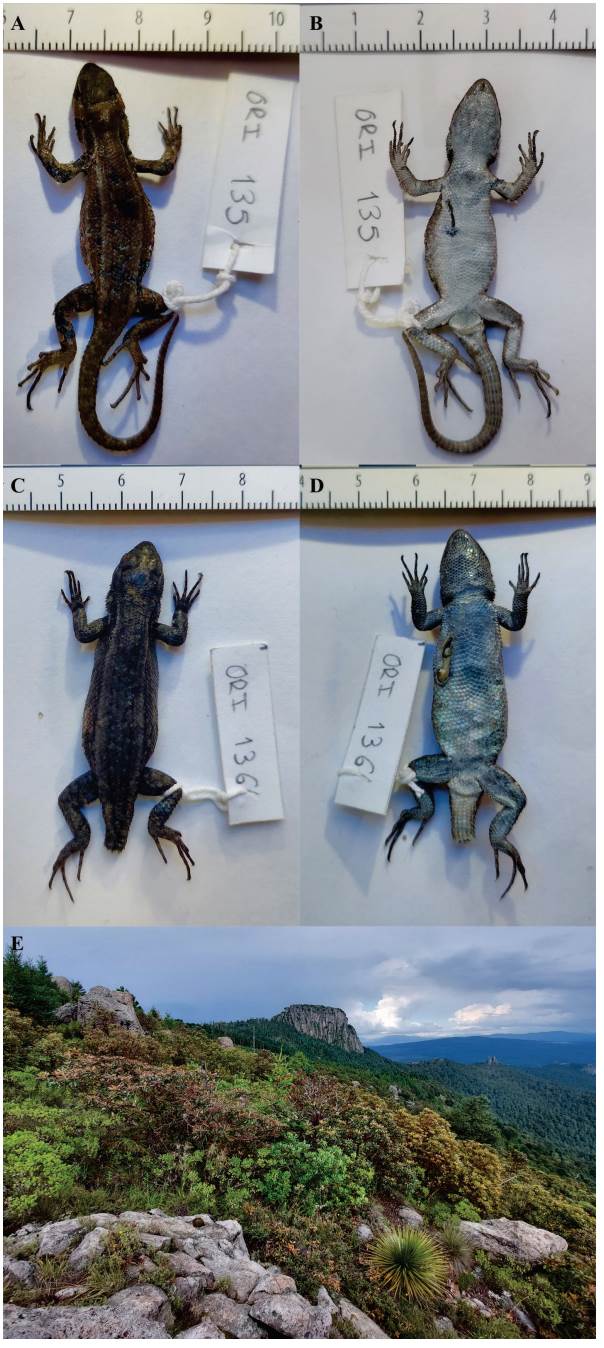The Largescale Spiny Lizard (Sceloporus megalepidurus; Smith, 1934) is a small (55 mm snout-vent length; SVL), terrestrial, and viviparous species. This Mexican endemic inhabits xerophilic scrubland, Yucca forest, Agave plantations, and rocky volcanic outcrops (González-Ruiz, 2014). Its distribution is narrow along the Sierra Madre Oriental in Hidalgo, Tlaxcala, Puebla, Oaxaca, the Estado de México, and central western Veracruz from 2100 to 2, 600 m of elevation (Fig. 1; Smith et al., 2006; Mata-Silva et al., 2015; Woolrich-Piña et al., 2017; Lemos-Espinal & Smith, 2015; 2020a; Torres-Hernández et al., 2021). This species was recorded 40 years ago at 2500 m a.s.l. on La Malinche volcano (Colección Nacional de Anfibios y Reptiles-Universidad Nacional Autónoma de México, CNAR-IB 3836; Méndez-de la Cruz pers. comm.) but was not observed again after an extensive eight-year field sampling effort (Díaz de la Vega-Pérez et al., 2019). It was recently recorded at 3080 m a.s.l. near El Peñón de Tlaxco in Tlaxcala by citizen science records of iNaturalist (https://www.naturalista.mx/observations/82696014; GBIF, 2022).

Figure 1 Geographic distribution of the Largescale Spiny Lizard (Sceloporus megalepidurus). Records are from GBIF (2022) and field work. The blue star represents our new record of S. megalepidurus in El Peñon de Tlaxco, Tlaxcala.
Figura 1 Distribución geográfica de la lagartija espinosa de escamas grandes (Sceloporus megalepidurus). Los registros provienen de GBIF (2022) y trabajo de campo. La estrella azul representa nuestro nuevo registro de S. megalepidurus en El Peñón de Tlaxco, Tlaxcala.
On December 13th, 2021, we conducted field surveys between 2,500 and 3,445 m a.s.l. on the west slope of the Peñón de Tlaxco, Tlaxcala. We searched principally in grasslands and Yucca spp, Nolina spp, Pinus spp, and Abies spp forests. Nine S. megalepidurus were observed perched on a rocky outcrop in grassland with surrounding vegetation represented by pine forest (19.67º N, 98.20º W; WGS 84; 3,390 m elevation). Two adult females were captured: the first with a total length of 82 mm, tail length of 43 mm, and body mass of 1.6 g (MZFZ 4460), and the second with a total length of 102 mm, tail length of 57 mm, and body mass of 3.3 g (MZFZ 4461).
Both lizards presented 15 femoral pores unilaterally. The primary color of the specimens’ bodies were dark gray, with a dorsolateral light line at the sides. The venters of both specimens were immaculate (Fig. 2). Lizards were identified as S. megalepidurus based on the description by Smith et al. (2006)), following these characteristics: dorsolateral light line, bordered laterally by a dark band in turn bordered by a lateral light line, series of 12-13 small, irregular dark spots on either side of the midline, venter immaculate, 15 femoral pores unilaterally.

The Eastern Spiny Lizard (Sceloporus spinosus; Wiegmann 1828) is an oviparous species endemic to Mexico with terrestrial, saxicolous, and occasionally arboreal habits (Méndez-de la Cruz et al., 2013). It is one of the largest lizards in the genus, with an average SVL of 100 mm (Ramírez-Bautista et al., 2014). This lizard inhabits coniferous forests, Quercus forests, xerophilic scrubland, and deforested areas near crops, induced grasslands, and man-made structures (Flores-Villela & Gerez, 1994). S. spinosus can be found in Durango, Zacatecas, San Luis Potosí, south of Nuevo León, Tamaulipas, eastern Jalisco, Guanajuato, Querétaro, Hidalgo, the Estado de México, Mexico City, Tlaxcala, Puebla, and Oaxaca (Fig. 2; Grummer et al., 2015; Leyte-Manrique et al., 2015; Mata-Silva et al., 2015; Cruz-Sáenz et al., 2017; Woolrich-Piña et al., 2017; Lemos-Espinal et al., 2018; Lemos-Espinal & Smith 2015; 2020b). This species inhabits elevations between 1,300 (Grummer et al., 2015) and 2,543 m a.s.l. in El Chico, Hidalgo (Sinervo et al., 2010). Recently, this species was located at 2,670 m a.s.l. (CNAR-IB-RF 517-518), inhabiting surrounding areas of cornfields along dirt roads of La Malinche volcano, Tlaxcala (Díaz de la Vega-Pérez et al., 2019).

Figure 3 Geographic distribution of the Eastern Spiny Lizard (Sceloporus spinosus). Records are from Grummer et al. (2015), Sinervo et al. (2010), GBIF (2022), and field work. The blue star represents our new record of S. spinosus in La Malinche, Tlaxcala.
Figura 3 Distribución geográfica de la lagartija espinosa del este (Sceloporus spinosus). Los registros provienen de Grummer et al. (2015), Sinervo et al. (2010), GBIF (2022) y trabajo de campo. La estrella azul representa nuestro nuevo registro de S. spinosus en La Malinche, Tlaxcala.
On December 18th, 2021, we conducted field surveys between 2,950 and 3,200 m a.s.l. on the east slope of La Malinche volcano. We searched principally near cornfields, Pinus spp., and Abies spp. forests. We found and captured a lizard of the species S. spinosus; the lizard was discovered under bricks near an abandoned, old cabin in grassland with surrounding vegetation represented by pine forest (19.23º N, 97.97º W; WGS 84; 3,030 m of elevation) in the locality of San Juan Ixtenco, Tlaxcala. The lizard (MZFZ-IMG 361) - an adult male - had a total length of 175 mm, tail length 105 mm, and body mass of 23.3 g. It had a dark band in the middle of the dorsum with 14 irregular dark spots. This dark band is bordered laterally by two light bands and presents blue, black, and white stripes in the dewlap region. The ventral region is white (Fig. 4). The specimen was identified as S. spinosus, based on the following characteristics: large, keeled, and mucronate dorsal scales, two clear dorsal lines from the eye to the base of the tail, blue scale on the patch of the shoulder, two small blue ventral patches, blue, black, and white stripes in the dewlap region, 10 femoral unilateral pores, and two large postcloacal scales.

The first record extends the known maximum elevation limit of S. megalepidurus from 2600 m (Smith et al., 2006) to 3390 m a.s.l. Our second record extends the known maximum elevation limit of S. spinosus, previously posited by Díaz de la Vega-Pérez et al., (2019), from 2670 m (CNAR-IB-RF 517-518) to 3030 m a.s.l. Photos and specimens from this note were delivered to the herpetological collection of the Museo de Zoología, Facultad de Estudios Superiores Zaragoza (MZFZ) at Universidad Nacional Autónoma de México (UNAM). All fieldwork was conducted under collecting permits SGPA/DGSV/07931/21 and SGPA/ DGVS/03937/21, granted by the Secretaría de Medio Ambiente y Recursos Naturales (SEMARNAT).











 nova página do texto(beta)
nova página do texto(beta)


